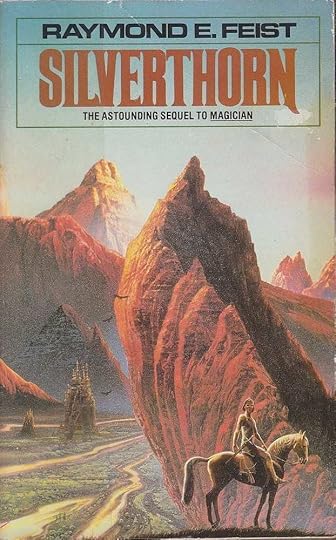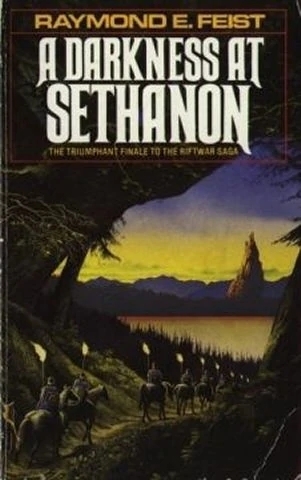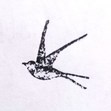Riftwar Re-Read #3 – Silverthorn and Sethanon
I’ve been powering ahead with the Riftwar series – I’ve just finished the third of the Legends books, so that’ll be a review post soon as well. But before I get too carried away, it’s time to talk about the remaining two books of the original saga. Magician might set up an entire universe, but it’s a sufficiently self-contained story to stand very well on its own. But its two direct sequels, Silverthorn and A Darkness at Sethanon, are too intrinsically linked to talk about individually. Though the A-plot of Silverthorn is largely resolved in that book alone, it’s very much a setup for Sethanon.

And it’s a damn good setup. Master magician Pug doesn’t take a back seat, per se, but the foreground very much belongs to Arutha, now Prince of Krondor, and ambitious young thief Jimmy the Hand, whose relatively brief appearance in Magician is definitely a highlight of that book. Given how much mileage Feist gets out of the wisecracking Jimmy and his journey – to say nothing of his various descendants – in the series to come, it’s definitely a good thing he took centre stage so early. On the surface, Silverthorn is a much more conventional fantasy adventure than Magician: on their wedding day, Princess Anita is shot with a poisoned arrow – the titular Silverthorn – the only antidote to which is hidden in the northern mountains on the other side of an army of dark elves currently plotting to take over the world. So off trot Arutha, Jimmy, and several other secondary characters from Magician to find the antidote, save the Princess, and stall the dark elf invasion along the way.
Meanwhile, in a plot that sets the tone for Pug’s role in the saga going forward, our favourite magician is off investigating the cause of the aforementioned dark elf invasion. Because of course it’s not just a military matter: dark magic from the beginning of time, twined up with the Dragon Lords, the mysterious Macros the Black, and the good old rifts, are all in play. While Arutha deals with the physical threat, Pug takes on the dark forces in the background, reopening the rift between worlds and uncovering some nicely apocalyptic cosmic threats. As I mentioned back in my first post, this is a basic structure that will be repeated constantly throughout the series: Pug, Tomas and various other magical folk yet to appear take on the cosmic Big Bads, while Arutha and friends, and ultimately their descendants, deal with the Big Bads impact on Midkemia and the Kingdom. And it works well. For the duration of Silverthorn, the plots remain largely separate, as Pug is off playing Magical Sherlock Holmes. But in Sethanon – which I’ll come to in a minute – everything comes together.
I like Silverthorn. Arutha is a well-written slightly broody hero, quick-witted but dour. As is remarked, to my lasting amusement, throughout the series, he “does take the fun out of life.” (He in fact creates more fun by forcing those who remark on this tendency into roles they are suited for but do not desire.) Jimmy the Hand is an absolute delight – I’m sure I’ve unconsciously borrowed a lot from this sarcastic thief to construct Tal Wenlock. And lots of secondary characters from the first book get more time to shine: Pug’s fellow slave Laurie, now a nobleman; Martin the master hunter, some of the background Tsurani magicians. The world is established, and now its inhabitants can play. The quest for the Silverthorn is simple enough, which gives all the characters time to become nicely rounded and realistic, and it all culminates in some nicely epic fight sequences. A plucky band of heroes against the world: what’s not to like?
The only thing I miss in Silverthorn is the presence of the mighty Dragon Lord Tomas, who only shows up briefly at the end. But that’s ok. Because, having learned the identity of the Big Bad in his quest for knowledge, in Sethanon Pug enlists the help of his best friend to fly across the cosmos on dragonback to find Macros the Black at the edge of the universe. Meanwhile, the dark elf invasion set up in Silverthorn actually takes place, and Arutha, Jimmy and co. are kept busy fending it off while Pug, Tomas and Macros race to thwart the end of the world that the invasion’s success will bring. There is prophecy, there is time travel; there’s a genuinely compelling redemption arc for a villainous figure from Magician, there are the returns of several characters who you didn’t realise you missed but definitely make the book better for their presence. And, crucially, Tomas and Pug get to do a cosmic odyssey and kick some serious arse together, which is something I’d been wanting since Magician. In short, Sethanon is a great end to the original saga.

Fundamentally, it shows how good Feist is at worldbuilding and setup. There’s a lot of payoff to this book that I only noticed on this umpteenth reading. The whole dark elf invasion is set up in the first third of Magician – Pug and company have to fight their way through migrating dark elves, whose presence isn’t quite explained by the Tsurani invasion. At the time, everyone has more pressing things on their minds (like the Tsurani invasion) and so the elves get forgotten – but they’re migrating north, of course, to flock to the banner of their new chieftain, who is just beginning the unification necessary to launch the invasion in Sethanon ten years later. Similarly, the Big Bad (whose nature I shall not spoil) has been present as a dark legend since almost the moment Pug sets foot on Kelewan in Magician. The villain-turned antihero? Never seen on-page in Magician, but the primary antagonist for most of Arutha’s plotline in that book, and with all the reasons for his villainy and setup for his eventual redemption laid out in that book – it just takes actually meeting him for all that to become apparent. Similarly, these two books both introduce various characters and concepts that I know will become really important later on in the series.
Feist’s really got some foresight.
They’re not perfect books by any means, of course. There’s perhaps a bit too much ‘I planned all this from the very beginning’ on the part of Macros the Black in particular,, which leads to a bit too much exposition, the climactic final battle suffers from being far less epic than the protracted siege that preceded it (but said siege is really well written), and there are excessive notes of The Power of Friendship in the slightly too-neat final resolution of all the plotlines. While Feist is fantastic at setting things up, he sets up so many things for the future series that there’s not always room to properly set up all the things that end up being important for the immediate plot at hand.
in the slightly too-neat final resolution of all the plotlines. While Feist is fantastic at setting things up, he sets up so many things for the future series that there’s not always room to properly set up all the things that end up being important for the immediate plot at hand.
But fundamentally, Silverthorn and Sethanon are a pair of cracking books. The initial Riftwar saga is complete: two worlds have been exquisitely built, a vibrant cast of characters set up. While we don’t say goodbye to Arutha and company just yet, we’ll never see them in the foreground in quite the same roles ever again – but that’s ok. These two books gave them plenty of spotlight, and they’ve earned a quiet transition to a supporting role for the next generation. Literally. The next pair of books are all about their kids.
Well, after the videogame trilogy, of course. But we’ll get to that later.
And he might not be picking pockets anymore, but we’ve certainly not seen the last of Jimmy the Hand.



